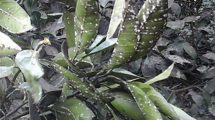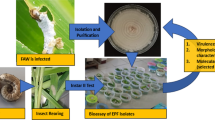Abstract
We report here that, during periodical surveys of insects inhabiting diverse habitats for the collection of entomopathogenic fungi; a large number of isolates were recovered belonging to seven species, from various regions of Madhya Pradesh and Chhattisgarh forest areas and agricultural fields. The most common entomopathogenic fungi such as Beauveria bassiana, Nomuraea rileyi, Paecilomyces farinosus and Paecilomyces fumosoroseus were found to infect various insect hosts species naturally viz. Hyblaea puera, Eutectona machaeralis, Diachrysia orichalcea, Spodoptera litura, and few new insect hosts of these fungal pathogens among Indian insect population were collected for the first time from Central India, such as beetles of Agrilus species, hairy caterpillars of Lymantria species. The isolation, identification, maintenance and pathogenicity assay of these isolates was performed prior to deposition in culture collection center.
Similar content being viewed by others
References
Goettel MS, Inglis GD and Wraight SP (2000) Special considerations for the application and evaluation of pathogens: fungi. In: Field Manual of Techniques in Invertebrate Pathology. Lacey LA, Kaya HK (Eds.), Kluwer Academic Press, Netherlands, pp 255–282
Lee SY, Nakaiima I, Ihara F, Kinoshita H and Nihira T (2005) Cultivation of entomopathogenic fungi for the search of antimicrobial compounds. Mycopathologia 160(4):321–325
Ali MIM and Varma RV (1994) Beauveria bassiana — a new insect pathogen on Atteva fabriciella and its comparative efficacy with Paecilomyces farinosus. Entomon 19:153–157
Visalakshy PNG and Jaynath KP (1995) A fungal pathogen attacking Neochetina eichhorniae and N. bruchi in Bangalore, India. Weed News 2:31–32
Ambethgar V (1997) Record of white muscardine fungus, Beauveria bassiana (Bals.) Vuill. on rice leaf folder complex from Karaikal, Pondicherry Union Territory (India). J Entomol Res 21(2):197–199
Ambethgar V and Loganathan M (1998) Incidence of green muscardine fungus, Nomuraea rileyi (Farlow) Samson, on Spodoptera litura (Fab.) in soybean, Glycine max (L.) Merrill, from Tamil Nadu (India). J Entomol Res 22:195–196
Gopalakrishnan C, Anusuya D and Narayanan K (1999) Occurrence of entomopathogenic fungi Paecilomyces farinosus (Holmskiold) Brown and Smith and Zoophthora radicans (Brefeld) Batko in the field population of Plutella xylostella L. on cabbage. Entomon 24:363–369
Selvasundaram R and Muraleedharan N (2000) Occurrence of the entomogenous fungus Beauveria bassiana on the shot hole borer of tea. J Plant Crops 28(3):229–230
Kulkarni NS and Lingappa S (2002) Seasonal incidence of entomopathogenic fungus Nomuraea rileyi (Farlow) Samson on Spodoptera litura in groundnut, soybean and potato — a comparative study. Karnataka J Agri Sci 15(1):63–70
Devi PS, Prasad YG, Chowdary DA, Rao LM and Balakrishnan K (2003) Identification of virulent isolates of the entomopathogenic fungus Nomuraea rileyi (F) Samson for the management of Helicoverpa armigera and Spodoptera litura. Mycopathologia 156(4):365–373
Niranjana SR (2004) Exploitation of entomopathogenic fungus Beauveria bassiana for efficient control of coffee berry borer in India. J Mycol Plant Pathol 34(3):714–723
McCoy CW, Samson RA and Boucias DG (1988) Entomogenous fungi. In: Handbook of Natural Pesticides. Vol. 5. Microbial Insecticides Part A. Entomogenous Protozoa and Fungi. Ignoffo CM, Mandava NB (Eds.), Fla Press Baco, Raton, pp 65–75
Kohlmeyer J and Kohlmeyer E (1972) Permanent microscopic mounts. Mycologia 64:666–669
Sandhu SS (1989) Epizootiological studies on Beauveria bassiana parasitizing Heliothis armigera Hub Pod borer of gram Cicer arietinum Linn. Ph.D Thesis, RD University, Jabalpur, MP, India
Lacey LA and Brooks WM (1997) Initial handling and diagnosis of diseased insects. In: Manual of Techniques in Insect Pathology. Lacey LA (Ed.), Academic Press, London, pp 1–16
Riddell RW (1950) Permanent stained mycological preparations obtained by slide culture. Mycologia 42: 265–270
Humber RA (1997) Fungi identification. In: Manual of Techniques in Insect Pathology. Lacey LA (Ed.), Academic Press, London, pp 153–185
Samson RA, Evans HC and Latge JP (1988) Atlas of Entomopathogenic Fungi. Springer-Verlag, Heidelberg, Germany
Barnett HL and Hunter BB (1972) Illustrated Genera of Imperfect Fungi. Minneapolis, Burgess
Smith D and Onions AHS (1994) The preservation and maintenance of living fungi. IMI Technical Handbook No. 2. International Mycological Institute. Wallingford, UK: CAB International
Sandhu SS, Rajak RC and Agarwal GP (1993) Bioactivity of Beauveria bassiana against Helicoverpa armigera effect of instar dosage and temperature. J Ind Bot Soc 72:81–84
Abbott WS (1925) A method for computing the effectiveness of an insecticide. J Economic Entomol 18:265–267
Finney DJ (1971) Probit Analysis. 3rd edition, Cambridge University Press, UK
Thakur R (2004) Taxonomic studies on entomopathogenic fungal diversity of Central India: biochemical and molecular aspects. Ph.D Thesis, RD University, Jabalpur, MP, India
Hatting JL, Humber RA, Tadeusz JP and Ray MM (1999) A survey of fungal pathogens of aphids from South Africa, with special reference to cereal aphids. Biol Cont 16:1–12
Evans HC (1982) Entomogenous fungi in tropical forest ecosystems: an appraisal. Eco Entomol 7:47–60
Charnley AK (1989) Mycoinsecticides: present use and future prospects. In: Progress and Prospects for Insect Control. British Crop Protection Council Monograph 43, pp 165–181
Vanninen I (1995) Distribution and occurrence of four entomopathogenic fungi in Finland: Effect of geographical location, habitat type and soil type. Mycol Res 100:93–101
Thakur R, Rajak RC and Sandhu SS (2005) Biochemical and molecular characteristics of indigenous strains of the entomopathogenic fungus Beauveria bassiana of Central India. Biocont Sci Tech 15(7):733–744
Barker CW and Barker GM (1998) Generalist entomopathogens as biological indicators of deforestation and agricultural land use impacts on Waikato soils. New Zea J Eco 22(2):189–196
Sandhu SS, Rajak RC, Agarwal GP and Mukherjee S (1994) Comparative susceptibility of two entomopathogenic fungi Paecilomyces farinosus and Verticillium lecanii against obnoxious mosquito sp. Culex pipiens. J Ind Bot Soc 73: 163–164
Mancalvo JM (1997) Evaluation of fungal biological diversity in the tropics. In: Systematic Perspectives in Tropical Mycology. Janardhanan KK, Rajendran C, Natrajan K, Hawksworth DL (Eds.), IBH publishing Co. Pvt. Ltd., Oxford
Destefano RHR, Destefano SAL and Messias CL (2004) Detection of Metarhizium anisopliae var. anisopliae within infected sugarcane borer Diatraea saccharalis (Lepidoptera: Pyralidae) using specific primers. Genet Mol Biol 27(2): 245–252
Inglis PW and Tigano MS (2006) Identification and taxonomy of some entomopathogenic Paecilomyces spp. (Ascomycota) isolates using rDNA-ITS Sequences. Genet Mol Biol 29(1):132–136
Author information
Authors and Affiliations
Corresponding author
Rights and permissions
About this article
Cite this article
Thakur, R., Sandhu, S.S. Distribution, occurrence and natural invertebrate hosts of indigenous entomopathogenic fungi of Central India. Indian J Microbiol 50, 89–96 (2010). https://doi.org/10.1007/s12088-010-0007-z
Received:
Accepted:
Published:
Issue Date:
DOI: https://doi.org/10.1007/s12088-010-0007-z




